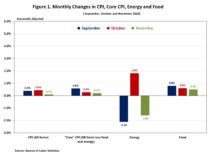Consumer prices in November saw the smallest year-over-year gain since December 2021.While still elevated, inflation experienced the second month below an 8% annual growth rate since February 2022. However, the shelter index continued to rise at an accelerated pace and was more than offsetting decreases in energy indexes. Shelter inflation will primarily be cooled in the future via additional housing supply. As inflation appears to have peaked and continues to slow, this may ease some of pressure on the Fed to maintain a more aggressive monetary policy.
The Bureau of Labor Statistics (BLS) reported that the Consumer Price Index (CPI) rose by 0.1% in November on a seasonally adjusted basis, following an increase of 0.4% in October. The price index for a broad set of energy sources fell by 1.6% in November as the gasoline index (-2.0%), the natural gas index (-3.5%) and the electricity index (-0.2%) all declined. Excluding the volatile food and energy components, the “core” CPI increased by 0.2% in November, following an increase of 0.3% in October. This is the smallest monthly increase since August 2021. Meanwhile, the food index increased by 0.5% in November with the food at home index also rising 0.5%.
Most component indexes continued to increase in November. The indexes for shelter (+0.6%), communication (+1.0%), recreation (+0.5%), motor vehicle insurance (+0.9%), education (+0.3%) as well as personal care (+0.7%) showed sizeable monthly increases in November. Meanwhile, the indexes for used cars and trucks (-2.9%), medical care (-0.5%) and airline fares (-3.0%) declined in November.
The index for shelter, which makes up more than 40% of the “core” CPI, rose by 0.6% in November, following an increase of 0.8% in October. The indexes for owners’ equivalent rent (OER) increased by 0.7% and rent of primary residence (RPR) increased by 0.8% over the month. Monthly increases in OER have averaged 0.7% over the last three months. More cost increases are coming from this category, which will maintain pressure on inflationary forces in the months ahead. These higher costs are driven by lack of supply and higher development costs. Higher interest rates will not slow these costs, which means the Fed’s tools are limited in addressing shelter inflation.
During the past twelve months, on a not seasonally adjusted basis, the CPI rose by 7.1% in November, following an 7.7% increase in October. The “core” CPI increased by 6.0% over the past twelve months, following a 6.3% increase in October. The food index rose by 10.6% and the energy index climbed by 13.1% over the past twelve months.
NAHB constructs a “real” rent index to indicate whether inflation in rents is faster or slower than overall inflation. It provides insight into the supply and demand conditions for rental housing. When inflation in rents is rising faster (slower) than overall inflation, the real rent index rises (declines). The real rent index is calculated by dividing the price index for rent by the core CPI (to exclude the volatile food and energy components).
The Real Rent Index rose by 0.6% in November. Over the first eleven months of 2022, the monthly change of the Real Rent Index increased by 0.2%, on average.
Discover more from Eye On Housing
Subscribe to get the latest posts sent to your email.




Is inflation realky moderating? The inflation rate is a measure of the inxrease or decrease in inflation compared to same month of the prior year. This can cloud the issue since, if the rate in the prior year was low, the increase is likely to appear to be high and, conversely if the rate of the previous year was high, the increase is more likely to appear to be low.
In my opinion, the best way to judge what is happening to inflation is to add the rate from the prior year to the current month’s rate and compare those combined totals to previous mknths.
if you do this for October, you add the rate for that month in 2021(6.2%) to the October 2022 rate (7.7%) for a total increase of 13.9% since October 2020.
For November, you add the 2021 rate (6.9%) to the November 2022 rate (7.1%) for a total increase of 13.9% since November 2020.
In conclusion, in my opinion, inflation hasn’t really declined at all. The current rate is just being compared to a month in which inflation was high.
Well said! So who benefits when the inflation is calculated without putting it into “correct” context?
Those in government who falsely claim that inflation is beginning to be controlled. seek to benefit politically. Have you watched any White House press conferences? Had Chairman Powell not ignored the inflation until he secured his reappointment, we would be months ahead of where we are. It appears that he feared he would not be reappointed if he tanked the only bright spot in the economy at the time, the equities markets. In the 1980’s, it took years to get inflation under control and it didn’t happen until the FED raised interest rates to the same level as the inflation rate. As Yogi said, “It’s not over ‘til it’s over.”